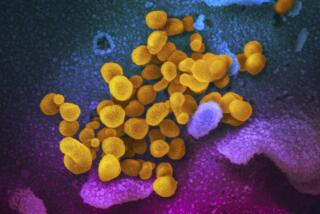Workers’ Error Destroys Mice Used in Key AIDS Experiment
- Share via
WASHINGTON — A special colony of 130 mice that had been genetically altered to develop AIDS was destroyed by workers at the National Institutes of Health who mistakenly cut off all air to the sealed chambers they lived in.
The mice, whose cells each contained a copy of the AIDS virus’ genes, were among the first animal models of the fatal disease. The experiment has been viewed by AIDS experts as one of the most promising and important in the country. Its abrupt interruption is expected to slow the rapid pace at which scientists are discovering how the AIDS virus works.
“I look at this as a pretty major setback for my program and for AIDS research at NIH,” said Malcolm Martin, a leading virologist at the National Institute of Allergy and Infectious Diseases, who had directed the research at the laboratory in Bethesda, Md. “We had a great disease model. And now we will have to repeat most of our work. Obviously, its somewhat distressing.”
The mishap occurred Saturday when electrical power was cut to replace a control device that helped regulate the heating, air conditioning and alarm systems in the facility, officials said.
The mouse experiments began more than a year ago when scientists started raising mice carrying genes for the AIDS virus in every cell in their bodies. The genes, copies of those carried by the AIDS virus, were spliced into the chromosomes of the mice.
The controversial experiment was the first in which the complete genetic code for an organism causing a fatal human disease had been inserted into another animal species, and the mice were the first animals other than humans to become sick as a result of the human immunodeficiency virus, which causes AIDS.
More to Read
Sign up for Essential California
The most important California stories and recommendations in your inbox every morning.
You may occasionally receive promotional content from the Los Angeles Times.













